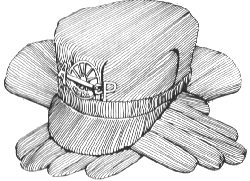
To receive a Master Builder - Cars AP Certificate, you must build eight cars. There must be at least four different types, and one must be a passenger car. At least four must be scratchbuilt and the remainder super-detailed. Those are the requirements, and they don't sound too difficult.
I enjoy scratchbuilding, so to satisfy these requirements, I scratchbuilt all eight cars. There really isn't much difference between building a craftsman type kit and scratchbuilding. The only difference I can see is that the manufacturer has put together all the stripwood, scribed siding, and detail parts you need in a box. If you take the plans and instructions and go to the hobby shop and buy the materials, you would be scratchbuilding. The source of many plans and instructions are found in the various model railroad publications. Whether building a craftsman kit or scratchbuilding, the sequence is similar. First you build the floor, then the sides, ends, and finally the roof. Then you put on the detail bits, paint and decal. Simple, isn't it?
First, try a craftsman kit. Don't let it overwhelm you. It may be a little trouble, but it gets easier the more you build. If you get a plastic craftsman kit, these are usually highly detailed; therefore, you may not earn extra points from judges. I recommend you also construct a wood craftsman kit with more details that you must add. For freight cars, you want brake piping and rods, grabirons, steps and that sort of thing. For passenger cars, look for the same items plus more underbody and roof details; also an interior. It is these detail items that will earn more points.
While on the subject of judging, remember that you do not necessarily have to enter a model contest to have your model judged. It is recommended to have some placed in competition. You have the option of having a judging team do their evaluation at your home; having them judged at a division meet, or entering your model in a contest. Most Master Builders have a few award-winning model cars.
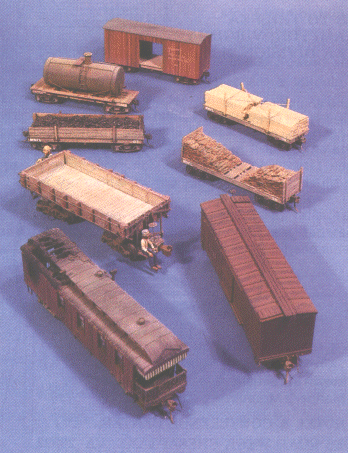
In the background the boxcar, tank car, flatcar, gondola, and bulkhead flat are all Sn42 scratchbuilt models. No commercial parts except the trucks and couplers were used so as to maximize the points for scratchbuilding. The On3 tilt-bottom gondola in the foreground is entirely scratchbuilt, including figures, trucks and couplers. The brakes work and the body tilts. The passenger car is an HO scale model with interior detail, working windows and doors. The boxcar in the foreground is an HO scale craftsman kit with extra underbody detail added. These were the eight cars Pat Harriman used to satisfy the AP requirements. Photo by Pat Harriman.
To increase the points on a kit-built model, you could scratchbuild the extra details. Adding an interior to a passenger car or caboose adds points. For freight cars, put a load in the car if it's open. With a boxcar, leave one door open so you can see the load. Also adding a figure to a model for effect, may add points. Don't forget maintenance-of-way as a type of car for this category, along with its many details.
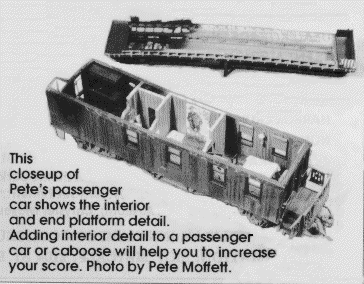
This closeup of Pat's passenger car shows the interior and end platform detail. Adding interior to a passenger car or caboose will help you to increase your score.
When you are scratchbuilding your car, you will not have a hard time gaining points. Look for an article in current and back issues of magazines which catches your eye and build from it. Start with a simple car. A flatcar is a good example. Also use the raw materials you feel comfortable with. The article is like the instructions in a kit. Often a bill of materials is included, so you can get your supplies at a good hobby shop.
After constructing a flatcar or gondola, be sure to build an interesting load for it. This is another way to display your scratchbuilding talents.
Another idea to consider is to take the plans from a craftsman kit, purchase the materials and build another car. This becomes a scratchbuilt model.
Happy modeling.
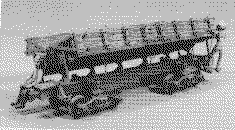
This On3 Quincy & Torch Lake tilt-bottom gondola features working tilt mechanism and working brakes. Making operating parts of a model where they would have operated on the prototype gives you a chance to gain extra points. The model also has two figures on it. This is another way of adding items to your model which may get you more points. Photo by Pat Harriman.
You don't always have to start out with a merit award car, which for some of us might be a forbidding task. Quite possibly some cars which you have already built could be up-graded to merit standards. Look over your cars, preferably scratchbuilt or craftsman kits, and see if some additions such as underbody and brake detail, better grabirons and steps, plus some weathering would bring them up to the required level. A side benefit of the Achievement Program is that your rolling stock roster begins to be sprinkled with eye-catching detailed models.
When presenting a car for AP judging, you can make it more helpful and enjoyable for the judges if you accompany it with a scrapbook of photos showing stages of construction, clippings from the construction article, and pictures of the prototype. Even more impressive is a card stock poster with these items mounted on it. Be sure to point out on the entry form any unusual materials or techniques you used. All of this benefits your point score.
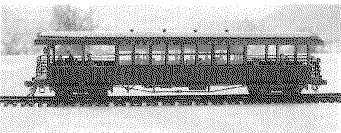
CP open observation car scratchbuilt by Bob Gardner from a November 1971 Model Railroader article.
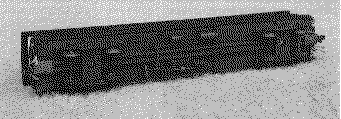
Underbody of CP observation car. Photos by Bob Gardner. The Canadian Pacific open observation car, from a November 1971 Model Railroader article, incorporates several of these features. The roof ventilators were made from earring clamps, the air hoses from scrap spring material, the turnbuckles and queen posts from brass tubing, the brake hanger brackets, steps, rain gutter brackets, railings and coupler release lever all from brass shim stock.
In the "Finish" area, points are often missed by not weathering a car. Remember, even a car that has made one trip will have some evidence of weathering. Realistic appearance is the key. Following these ideas, your models will earn you the requirements for Master Builder-Cars.
You can do it!
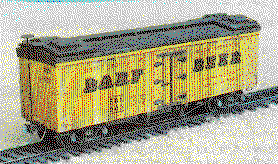
Barf Beer reefer scratchbuilt by Bob Gardner using scrap materials and commercial rub-on lettering.
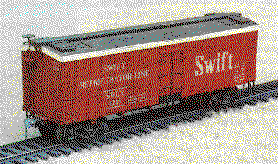
Swift reefer scratchbuilt by Bob Gardner in 1956 and improved for AP judging. Car is from an October 1953 Model Railroader article.